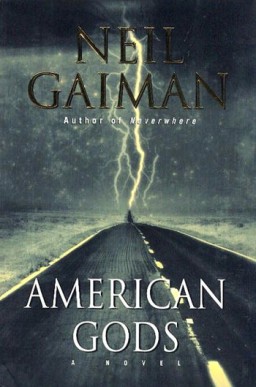In honor of City of Blades coming out, I re-read American Elsewhere, which–fun story–I hate-bought because the cover (and title) looked so much like American Gods. “Well this is going to be bullshit” I said, probably out loud, probably to myself in a crowded bookstore, probably earning myself nervous glances.
And then, readers, it wasn’t. It was not bullshit at all. It was so far from bullshit you would not believe.

For comparison

Whereas American Gods uses the iconic American journey, i.e., by car across vast distances, to say something about how weird this country can be, American Elsewhere largely stays put in order to draw out the strange. Neither book fully encompasses the vastness of America–I’d like to note that neither book even gets as far as the Rockies, let alone California–but while Gods drifts more northerly, Elsewhere stays South. Not the Southeast, where it would have to turn into Southern Gothic, but the oft-neglected Southwest.
Having recently visited and had my mind blown, I can say that it’s rich territory for both fantasy and horror, which American Elsewhere blends quite masterfully. It’s a land of infinities. The sky is huge, the desert is vast, and the colors are beyond anything my East Coast mind was ready for. In a way, it’s the perfect place for Lovecraftian horror, because everything is already sitting on that edge of what the human mind can encompass. These really are colors out of space, and strange geometries of stone that are nothing like our mountains or fields. And as far as mythologies, Bennett even says it: “It suddenly feels as if all of America’s nasty secrets could be found out here among the rock and sand, buried in the wilderness, forgotten.” Vampires would perish here, and werewolves would starve–but other, less defined creatures? Yeah, they’re probably lurking.
Exactly where and why they’re lurking is the more potent issue for the characters of American Elsewhere, especially it’s main. Mona, an object in motion trying to stay in motion, comes clamoring to rest in Wink. She’s looking to lay claim to her deceased mother’s house, a property that her father kept from her either out of sullen malice or drunken forgetfulness. But he’s dead now too, and Mona doesn’t really much care, except to be annoyed that he left so little information about the house. All she knows is that it’s in a town called Wink, NM. And since she’s been spending years wandering, trying to forget her crappy past and her equally crappy future, why not wander on out to Wink?
Well, as it turns out there are lots of very good reasons not to go, but they’re the kinds of things you don’t find out until after. After what? Well…after. After arriving, after interrupting a funeral, after seeing the house, after hearing from neighbor after neighbor that no, no they’d positively absolutely never met her mother. After nearly everything, there is a moment of distortion. Something is wrong in Wink. Very wrong. But while Mona is poking around the periphery of it, others are stabbing straight at its heart, and bringing chaos and murder to the seemingly peaceful town.
Though there’s only one central weirdness here, and one central mystery, you’ll find that there are some striking similarities between American Elsewhere and the podcast Welcome to Nightvale. They came out pretty much concurrently, so this is an instance of convergent evolution rather than inspiration, I believe. (How Southwestern Lovecraft is evolutionarily advantageous is beyond me, but I’m sure there must be a reason we crave being unnerved.) And if you like Nightvale, you’ll likely also be smitten with Mona’s quest to find a beautiful scientist–although in this case, it’s her mother, and not perfect-haired Carlos–and unravel the mystery of a blinking light and an abandoned research station.
Of course, if you’re not a fan of Welcome to Nightvale or have never heard of it, there’s still plenty to love. It’s creeping horror, not jump or gore horror, so it’s the kind of book you can enjoy quite happily during the day, or with a certain degree of heebie-jeebies once night falls. The characters are very well-drawn, Mona especially, so beautifully of spite and sadness and longing and wonder. And of course the writing is the same blend of sass and seriousness you can expect from a Bennett novel.
Buy this–or hate-buy it, I don’t care, so long as you read it. At 600+ pages, it will take you right up until the 26th, and then you won’t have to wait for City of Blades any longer!
